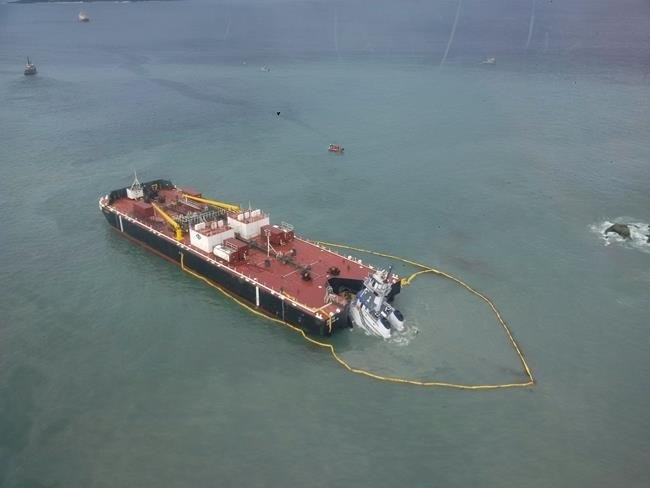In the early morning last Thursday, the tugboat Nathan E. Stewart and barge DBL 55 were travelling back down the B.C. coast after delivering petroleum products in Ketchikan, Alaska.
The tug passed the Ivory Island lighthouse, 11.5 kilometres north of Bella Bella, where its crew should have made a gentle turn to the southeast, passing easily between the rocky reef off Athlone Island and the mainland.
Instead, according to a record of the vessels’ GPS path from MarineTraffic.com, it plowed straight ahead at 9.4 knots. The tug scraped hard on the reef, tearing open two of its fuel tanks and spilling diesel into the cold seawater. It was 1:13 a.m.
Coast Guard vessels responded quickly to rescue the seven-person crew and provide assistance. By first light, boats from the Heiltsuk First Nation were on the scene, along with a small crew subcontracted by Western Canada Marine Response Corporation (WCMRC), the controversial industry-owned private company responsible for oil spill cleanup along the B.C. coast. The company’s workers deployed four 50-metre booms around the stranded tug and helped pump 6,554 litres of fuel from the tug into an empty tank on the barge. It was 10 hours after the crash before the first containment booms were effectively in place.
That afternoon a set of 1,000-metre booms were deployed across the mouth of Gale Creek in an effort to slow the slick’s spread. They were pulled apart by strong currents and didn’t last the night.
Almost one week on, a double boom system with absorbent pads is mostly containing the slick remaining around the tug. Replacement booms across Gale Creek are holding. The bulk of the spill – which was never contained – continues to spread.
Diesel: A deceptively dangerous fuel
In theory, marine diesel’s light weight and thin consistency should make it easier to clean up than bunker fuel or bitumen. It typically floats on top of water, creating a sheen only a few microns thick. The U.S. National Oceanographic and Atmospheric Agency notes that diesel is often broken up by wave action in a few weeks or months, and particles are pushed deeper into the water column to be broken down by microorganisms.
For cleanup crews, that might be comforting. For the Heiltsuk, it is devastating.
The Heiltsuk rely on these waters for sustenance and income, and this spill occurred over the site of their commercial clam fishery and during their annual sea cucumber harvest. The sale of clams alone generates around $150,000 a year. Five days after the spill, the federal Department of Fisheries and Oceans ordered an emergency closure for shellfish and sea cucumber harvesting. It is unknown when they will open again.
The effects aren’t just environmental and economic, devastating as those are. There are also human health impacts to worry about.
In the “world class” oil spill response system so often touted by politicians, local volunteers should not have to put their bodies on the front line.
But the only marine spill response crews are stationed in Prince Rupert and Richmond/Victoria. Crews called down from Prince Rupert had to travel more than 300 kilometres to reach the spill site, a trip that took nearly a day.
While management and planners from WCRMC, contracted salvage companies and Kirby Offshore Marine, the tug’s Texas-based owner, were able to fly up before a wave of storms hit, technical staff and specialized equipment were stuck in transit, finally arriving Sunday night.
In their absence, Heiltsuk volunteers, including elders and hereditary chiefs, stepped in. Since the spill began, they’ve worked virtually non-stop to help secure the tug, maintain booms and survey shorelines.
And yet, according to a person involved in the effort who wished to remain anonymous, they were not offered access to protective gear until more than 24 hours after response efforts began (the Coast Guard gave them gloves to protect their hands). It took until Saturday before someone remembered there was safety gear stowed on the DBL 55 barge – including respiratory protection – and made it available.
Jess Housty, elected councillor for the Heiltsuk Tribal Council, says it is hard to determine how many people are experiencing adverse symptoms from the spill.
“We know there are people who’ve had headaches, irritation in their noses and lungs since day one,” says Housty. “They’re not reporting them because they don’t want to be told they can’t go out and help anymore. They can’t imagine being anywhere else.”
The Unified Command – a group comprised of the Heiltsuk First Nation, the provincial government, Kirby and the Canadian Coast Guard – has told kids under 14 that they can’t go on crews anymore. “It’s been heartbreaking for the kids, they feel like they’re able-bodied, they’re passionate and and they’re scared,” Housty said. “We don’t want to tell them they can’t go out, but we need to protect their health.”
The crews are now focused on preparing the tug for refloating, a dangerous and complicated effort. Hot tapping – a 40 to 50 hour process in which divers use underwater drills and pumps to extract the remaining diesel and oil from the sunken tug before it can be floated and moved to a barge for transport south – has been under way since late Monday night. But it was briefly halted as a major storm rolled in Wednesday morning, bringing 50 to 60 km/h winds and two metre waves. Should the tug stay in place during the storm – and there’s a chance it won’t – efforts will begin again when the weather improves.
More questions than answers
At the moment much is still unclear, including the cause of the accident.
The Nathan E. Stewart regularly carried loads of liquid petroleum products from the south coast to ports in Alaska. Due to its relatively small load, the Pacific Pilotage Authority allowed the vessel to travel up and down B.C.’s rugged and unpredictable coast without a certified marine pilot. That waiver has been rescinded, pending an investigation.
Over the last few days Transport Canada and Kirby Offshore Marine officials have conducted interviews with the seven crew members of the Nathan E. Stewart.
According to the Heiltsuk, they have refused to share their findings with the other members of the Unified Command, and have told the Heiltsuk that they cannot conduct their own interviews unless individual crew members consent.
In response, the Heiltsuk have launched their own investigation, soliciting impact statements from community members and pursuing rigorous environmental monitoring.
Housty, like many of the people working on this spill, is exhausted and frustrated, particularly with the response – or lack thereof – from politicians. While Prime Minister Justin Trudeau deftly evaded making another firm promise when asked about the spill and his plans for a tanker ban, Premier Christy Clark inserted herself in its narrative, attacking the federal government for its “totally inadequate” spill response.
Housty says neither of their words are enough.
As for Clark, Housty says that “a good government would have done what’s within their jurisdiction and offered help. It’s pretty appalling that her first reaction was to duck blame instead of thinking about what she and her government could have done there.”
Nearly a week after it sank, the Nathan E. Stewart’s stern still rests on the bottom in nine metres of water. Its diesel fuel slick still coats large swathes of Seaforth Channel. It has polluted tide pools, shoreline grasses and vital fishing grounds.
Late Wednesday night, elected Heiltsuk chief Marilyn Slett tweeted that one of the boats assisting in the cleanup had sunk as well. This crisis is far from over, and much of the hard work is still ahead. Things in Bella Bella will not be the same for a long, long time.
Why the Nathan E. Stewart was ever allowed to travel these waters without properly trained pilot staff is a question that needs to be answered. What all levels of colonial government will do to prevent it – or an even bigger oil transport disaster – from happening again is another.
No one can look at this response – hindered by weather, bureaucracy, and distance – and find that it is “world class” in any way. ![]()
Read more: Environment















Tyee Commenting Guidelines
Comments that violate guidelines risk being deleted, and violations may result in a temporary or permanent user ban. Maintain the spirit of good conversation to stay in the discussion.
*Please note The Tyee is not a forum for spreading misinformation about COVID-19, denying its existence or minimizing its risk to public health.
Do:
Do not: